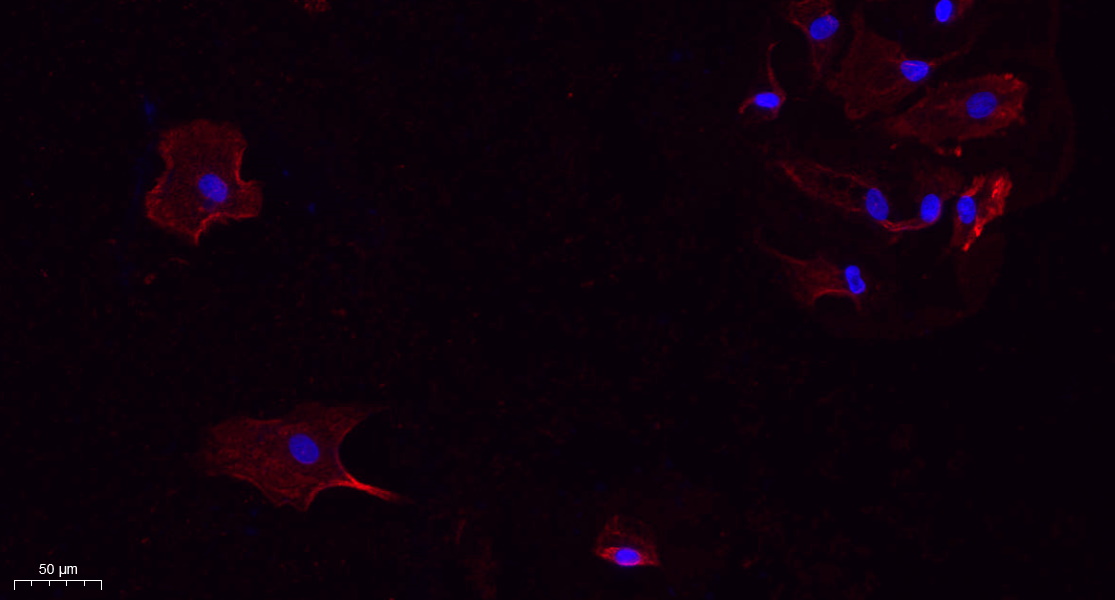RANKL Polyclonal Antibody
- Catalog No.:YT5404
- Applications:WB;IHC;IF;ELISA
- Reactivity:Human;Mouse;Rat
- Target:
- RANKL
- Fields:
- >>Cytokine-cytokine receptor interaction;>>NF-kappa B signaling pathway;>>Osteoclast differentiation;>>Prolactin signaling pathway;>>Parathyroid hormone synthesis, secretion and action;>>Chemical carcinogenesis - receptor activation;>>Breast cancer;>>Rheumatoid arthritis
- Gene Name:
- TNFSF11
- Protein Name:
- Tumor necrosis factor ligand superfamily member 11
- Human Gene Id:
- 8600
- Human Swiss Prot No:
- O14788
- Mouse Gene Id:
- 21943
- Mouse Swiss Prot No:
- O35235
- Rat Gene Id:
- 117516
- Rat Swiss Prot No:
- Q9ESE2
- Immunogen:
- The antiserum was produced against synthesized peptide derived from the C-terminal region of human TNFSF11. AA range:268-317
- Specificity:
- RANKL Polyclonal Antibody detects endogenous levels of RANKL protein.
- Formulation:
- Liquid in PBS containing 50% glycerol, 0.5% BSA and 0.02% sodium azide.
- Source:
- Polyclonal, Rabbit,IgG
- Dilution:
- WB 1:500 - 1:2000. IHC: 1:100-300 ELISA: 1:20000. IF 1:100-300 Not yet tested in other applications.
- Purification:
- The antibody was affinity-purified from rabbit antiserum by affinity-chromatography using epitope-specific immunogen.
- Concentration:
- 1 mg/ml
- Storage Stability:
- -15°C to -25°C/1 year(Do not lower than -25°C)
- Other Name:
- TNFSF11;OPGL;RANKL;TRANCE;Tumor necrosis factor ligand superfamily member 11;Osteoclast differentiation factor;ODF;Osteoprotegerin ligand;OPGLReceptor activator of nuclear factor kappa-B ligand;RANKL;TNF-related activation-induced cytokine;TRANCE;CD254
- Observed Band(KD):
- 35kD
- Background:
- This gene encodes a member of the tumor necrosis factor (TNF) cytokine family which is a ligand for osteoprotegerin and functions as a key factor for osteoclast differentiation and activation. This protein was shown to be a dentritic cell survival factor and is involved in the regulation of T cell-dependent immune response. T cell activation was reported to induce expression of this gene and lead to an increase of osteoclastogenesis and bone loss. This protein was shown to activate antiapoptotic kinase AKT/PKB through a signaling complex involving SRC kinase and tumor necrosis factor receptor-associated factor (TRAF) 6, which indicated this protein may have a role in the regulation of cell apoptosis. Targeted disruption of the related gene in mice led to severe osteopetrosis and a lack of osteoclasts. The deficient mice exhibited defects in early differentiation of T and B ly
- Function:
- disease:Defects in TNFSF11 are the cause of osteopetrosis autosomal recessive type 2 (OPTB2) [MIM:259710]; also known as osteoclast-poor osteopetrosis. Osteopetrosis is a rare genetic disease characterized by abnormally dense bone, due to defective resorption of immature bone. The disorder occurs in two forms: a severe autosomal recessive form occurring in utero, infancy, or childhood, and a benign autosomal dominant form occurring in adolescence or adulthood. Autosomal recessive osteopetrosis is usually associated with normal or elevated amount of non-functional osteoclasts. OPTB2 is characterized by paucity of osteoclasts, suggesting a molecular defect in osteoclast development.,function:Cytokine that binds to TNFRSF11B/OPG and to TNFRSF11A/RANK. Osteoclast differentiation and activation factor. Augments the ability of dendritic cells to stimulate naive T-cell proliferation. May be an
- Subcellular Location:
- [Isoform 1]: Cell membrane; Single-pass type II membrane protein.; [Isoform 3]: Cell membrane; Single-pass type II membrane protein.; [Isoform 2]: Cytoplasm .; [Tumor necrosis factor ligand superfamily member 11, soluble form]: Secreted .
- Expression:
- Highest in the peripheral lymph nodes, weak in spleen, peripheral blood Leukocytes, bone marrow, heart, placenta, skeletal muscle, stomach and thyroid.
NCX1 disturbs calcium homeostasis and promotes RANKL-induced osteoclast differentiation by regulating JNK/c-Fos/NFATc1 signaling pathway in multiple myeloma
Protective effects of apple polyphenols on bone loss in mice with high fat diet-induced obesity WB Mouse 1 : 1000 femurs/
HIF‐1α facilitates osteocyte‐mediated osteoclastogenesis by activating JAK2/STAT3 pathway in vitro. JOURNAL OF CELLULAR PHYSIOLOGY 2019 Apr 29 WB,IF Mouse 1:200,1:500 MLO-Y4 cell
Alleviative Effects of Exercise on Bone Remodeling in Fluorosis Mice. BIOLOGICAL TRACE ELEMENT RESEARCH Biol Trace Elem Res. 2022 Mar;200(3):1248-1261 IHC,WB Mouse 1 : 100,1:400 Femur tissue
- June 19-2018
- WESTERN IMMUNOBLOTTING PROTOCOL
- June 19-2018
- IMMUNOHISTOCHEMISTRY-PARAFFIN PROTOCOL
- June 19-2018
- IMMUNOFLUORESCENCE PROTOCOL
- September 08-2020
- FLOW-CYTOMEYRT-PROTOCOL
- May 20-2022
- Cell-Based ELISA│解您多样本WB检测之困扰
- July 13-2018
- CELL-BASED-ELISA-PROTOCOL-FOR-ACETYL-PROTEIN
- July 13-2018
- CELL-BASED-ELISA-PROTOCOL-FOR-PHOSPHO-PROTEIN
- July 13-2018
- Antibody-FAQs
- Products Images

- Immunofluorescence analysis of A549. 1,primary Antibody(red) was diluted at 1:200(4°C overnight). 2, Goat Anti Rabbit IgG (H&L) - Alexa Fluor 594 Secondary antibody was diluted at 1:1000(room temperature, 50min).3, Picture B: DAPI(blue) 10min.

- Immunohistochemical analysis of paraffin-embedded Mouse-kidney tissue. 1,RANKL Polyclonal Antibody was diluted at 1:200(4°C,overnight). 2, Sodium citrate pH 6.0 was used for antibody retrieval(>98°C,20min). 3,Secondary antibody was diluted at 1:200(room tempeRature, 30min). Negative control was used by secondary antibody only.

- Western Blot analysis of 293 cells using RANKL Polyclonal Antibody. Secondary antibody(catalog#:RS0002) was diluted at 1:20000
.jpg)
- Immunohistochemical analysis of paraffin-embedded human-lung, antibody was diluted at 1:100

- Immunohistochemical analysis of paraffin-embedded human-Lymph-nodes, antibody was diluted at 1:100

- Western blot analysis of lysate from 293 cells, using TNFSF11 Antibody.
